Principles of Marketing: FROST Product Analysis and Market Segmentation
VerifiedAdded on 2023/04/21
|10
|2423
|175
AI Summary
This document provides an analysis of Nestle's FROST fruit drink product in the Australian market, including SWOT and PESTLE analysis. It also discusses market segmentation and targeting strategies.
Contribute Materials
Your contribution can guide someone’s learning journey. Share your
documents today.

Principles of marketing
Secure Best Marks with AI Grader
Need help grading? Try our AI Grader for instant feedback on your assignments.
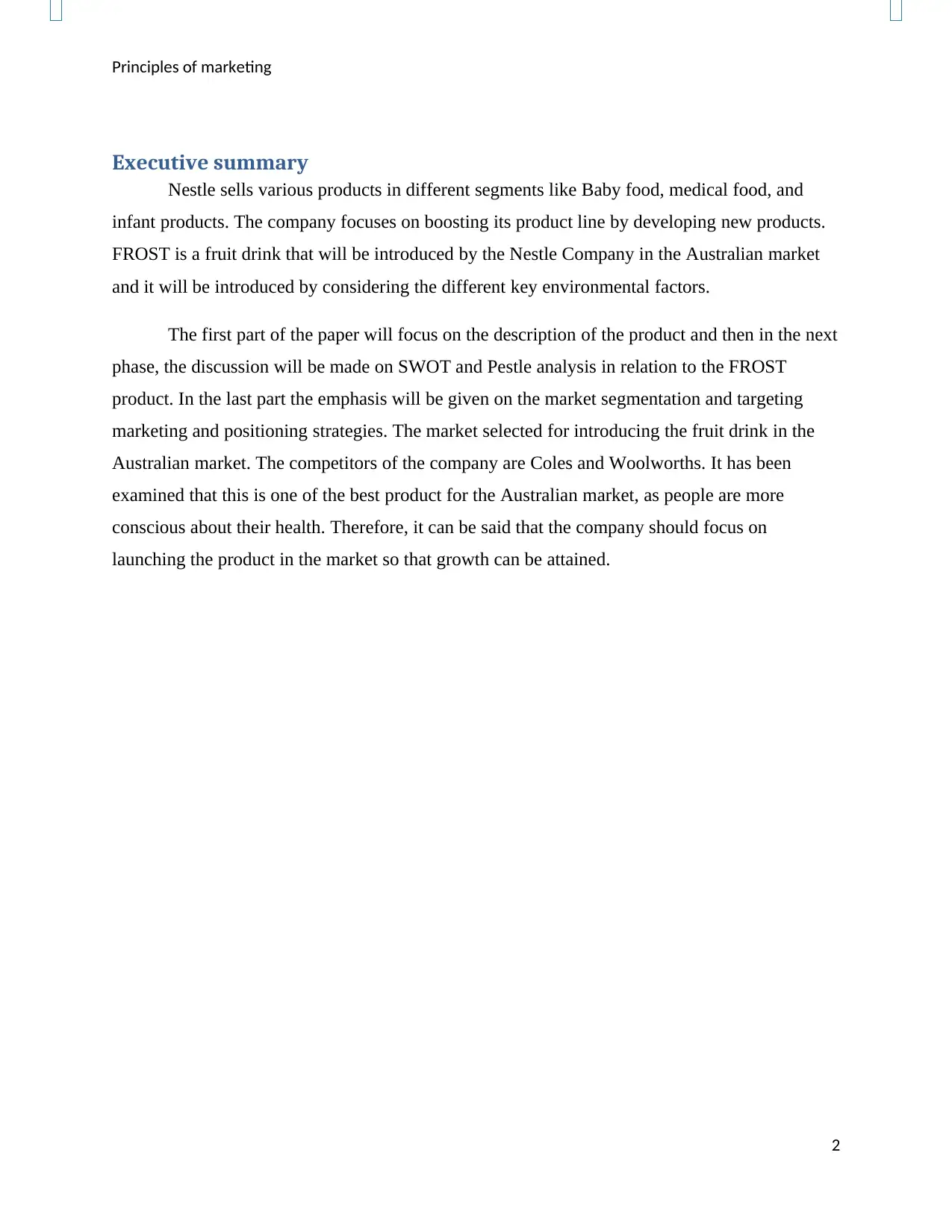
Principles of marketing
Executive summary
Nestle sells various products in different segments like Baby food, medical food, and
infant products. The company focuses on boosting its product line by developing new products.
FROST is a fruit drink that will be introduced by the Nestle Company in the Australian market
and it will be introduced by considering the different key environmental factors.
The first part of the paper will focus on the description of the product and then in the next
phase, the discussion will be made on SWOT and Pestle analysis in relation to the FROST
product. In the last part the emphasis will be given on the market segmentation and targeting
marketing and positioning strategies. The market selected for introducing the fruit drink in the
Australian market. The competitors of the company are Coles and Woolworths. It has been
examined that this is one of the best product for the Australian market, as people are more
conscious about their health. Therefore, it can be said that the company should focus on
launching the product in the market so that growth can be attained.
2
Executive summary
Nestle sells various products in different segments like Baby food, medical food, and
infant products. The company focuses on boosting its product line by developing new products.
FROST is a fruit drink that will be introduced by the Nestle Company in the Australian market
and it will be introduced by considering the different key environmental factors.
The first part of the paper will focus on the description of the product and then in the next
phase, the discussion will be made on SWOT and Pestle analysis in relation to the FROST
product. In the last part the emphasis will be given on the market segmentation and targeting
marketing and positioning strategies. The market selected for introducing the fruit drink in the
Australian market. The competitors of the company are Coles and Woolworths. It has been
examined that this is one of the best product for the Australian market, as people are more
conscious about their health. Therefore, it can be said that the company should focus on
launching the product in the market so that growth can be attained.
2
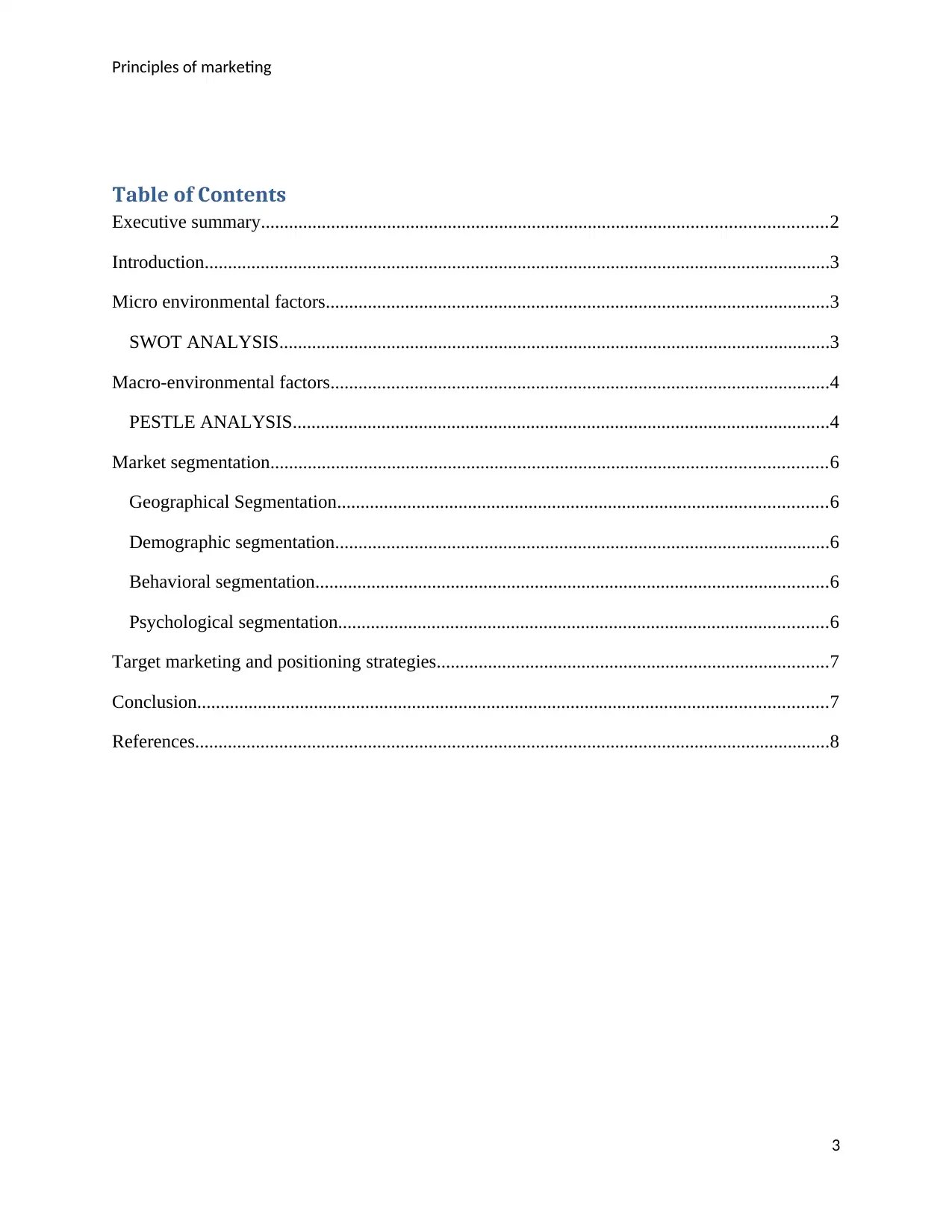
Principles of marketing
Table of Contents
Executive summary.........................................................................................................................2
Introduction......................................................................................................................................3
Micro environmental factors............................................................................................................3
SWOT ANALYSIS......................................................................................................................3
Macro-environmental factors...........................................................................................................4
PESTLE ANALYSIS...................................................................................................................4
Market segmentation.......................................................................................................................6
Geographical Segmentation.........................................................................................................6
Demographic segmentation..........................................................................................................6
Behavioral segmentation..............................................................................................................6
Psychological segmentation.........................................................................................................6
Target marketing and positioning strategies....................................................................................7
Conclusion.......................................................................................................................................7
References........................................................................................................................................8
3
Table of Contents
Executive summary.........................................................................................................................2
Introduction......................................................................................................................................3
Micro environmental factors............................................................................................................3
SWOT ANALYSIS......................................................................................................................3
Macro-environmental factors...........................................................................................................4
PESTLE ANALYSIS...................................................................................................................4
Market segmentation.......................................................................................................................6
Geographical Segmentation.........................................................................................................6
Demographic segmentation..........................................................................................................6
Behavioral segmentation..............................................................................................................6
Psychological segmentation.........................................................................................................6
Target marketing and positioning strategies....................................................................................7
Conclusion.......................................................................................................................................7
References........................................................................................................................................8
3
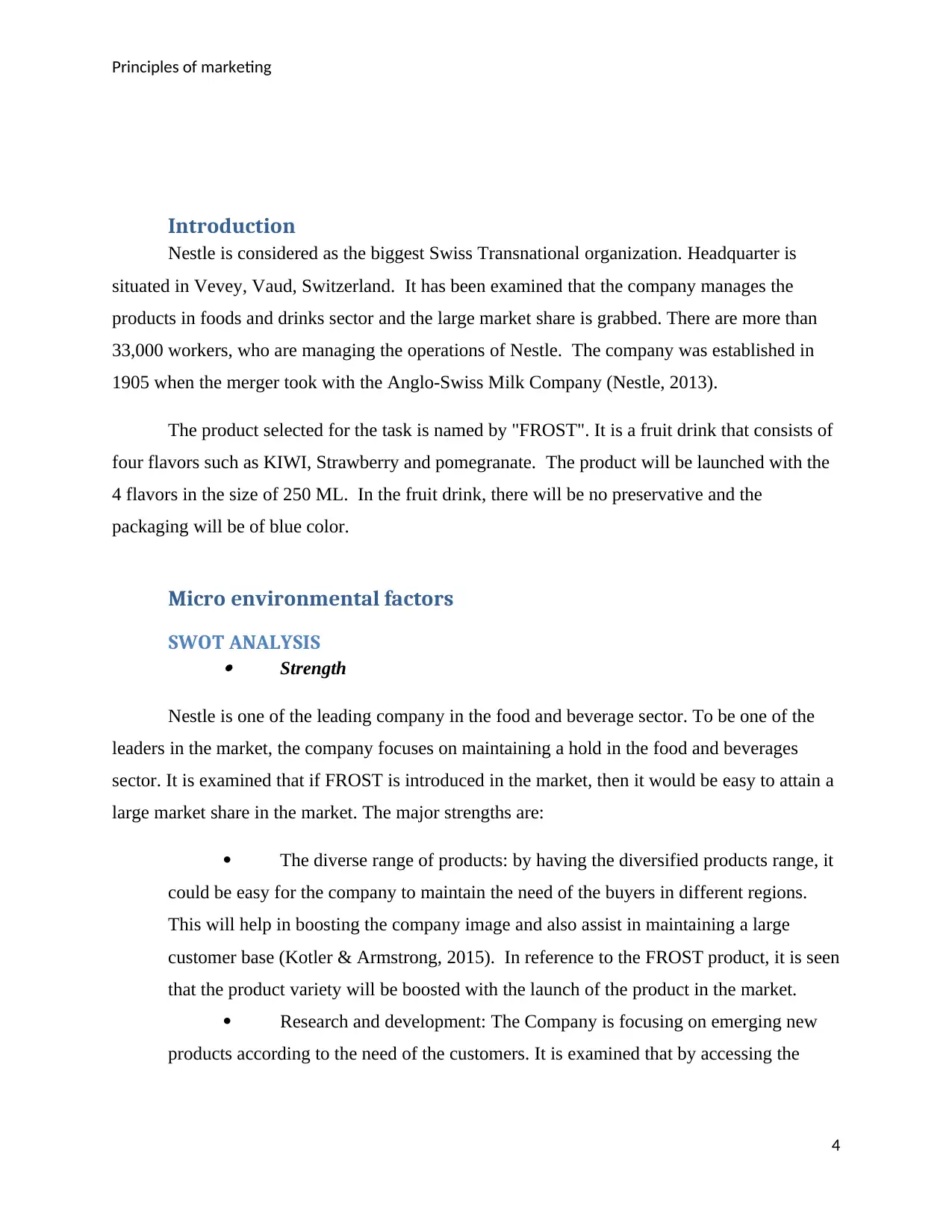
Principles of marketing
Introduction
Nestle is considered as the biggest Swiss Transnational organization. Headquarter is
situated in Vevey, Vaud, Switzerland. It has been examined that the company manages the
products in foods and drinks sector and the large market share is grabbed. There are more than
33,000 workers, who are managing the operations of Nestle. The company was established in
1905 when the merger took with the Anglo-Swiss Milk Company (Nestle, 2013).
The product selected for the task is named by "FROST". It is a fruit drink that consists of
four flavors such as KIWI, Strawberry and pomegranate. The product will be launched with the
4 flavors in the size of 250 ML. In the fruit drink, there will be no preservative and the
packaging will be of blue color.
Micro environmental factors
SWOT ANALYSIS
Strength
Nestle is one of the leading company in the food and beverage sector. To be one of the
leaders in the market, the company focuses on maintaining a hold in the food and beverages
sector. It is examined that if FROST is introduced in the market, then it would be easy to attain a
large market share in the market. The major strengths are:
The diverse range of products: by having the diversified products range, it
could be easy for the company to maintain the need of the buyers in different regions.
This will help in boosting the company image and also assist in maintaining a large
customer base (Kotler & Armstrong, 2015). In reference to the FROST product, it is seen
that the product variety will be boosted with the launch of the product in the market.
Research and development: The Company is focusing on emerging new
products according to the need of the customers. It is examined that by accessing the
4
Introduction
Nestle is considered as the biggest Swiss Transnational organization. Headquarter is
situated in Vevey, Vaud, Switzerland. It has been examined that the company manages the
products in foods and drinks sector and the large market share is grabbed. There are more than
33,000 workers, who are managing the operations of Nestle. The company was established in
1905 when the merger took with the Anglo-Swiss Milk Company (Nestle, 2013).
The product selected for the task is named by "FROST". It is a fruit drink that consists of
four flavors such as KIWI, Strawberry and pomegranate. The product will be launched with the
4 flavors in the size of 250 ML. In the fruit drink, there will be no preservative and the
packaging will be of blue color.
Micro environmental factors
SWOT ANALYSIS
Strength
Nestle is one of the leading company in the food and beverage sector. To be one of the
leaders in the market, the company focuses on maintaining a hold in the food and beverages
sector. It is examined that if FROST is introduced in the market, then it would be easy to attain a
large market share in the market. The major strengths are:
The diverse range of products: by having the diversified products range, it
could be easy for the company to maintain the need of the buyers in different regions.
This will help in boosting the company image and also assist in maintaining a large
customer base (Kotler & Armstrong, 2015). In reference to the FROST product, it is seen
that the product variety will be boosted with the launch of the product in the market.
Research and development: The Company is focusing on emerging new
products according to the need of the customers. It is examined that by accessing the
4
Secure Best Marks with AI Grader
Need help grading? Try our AI Grader for instant feedback on your assignments.
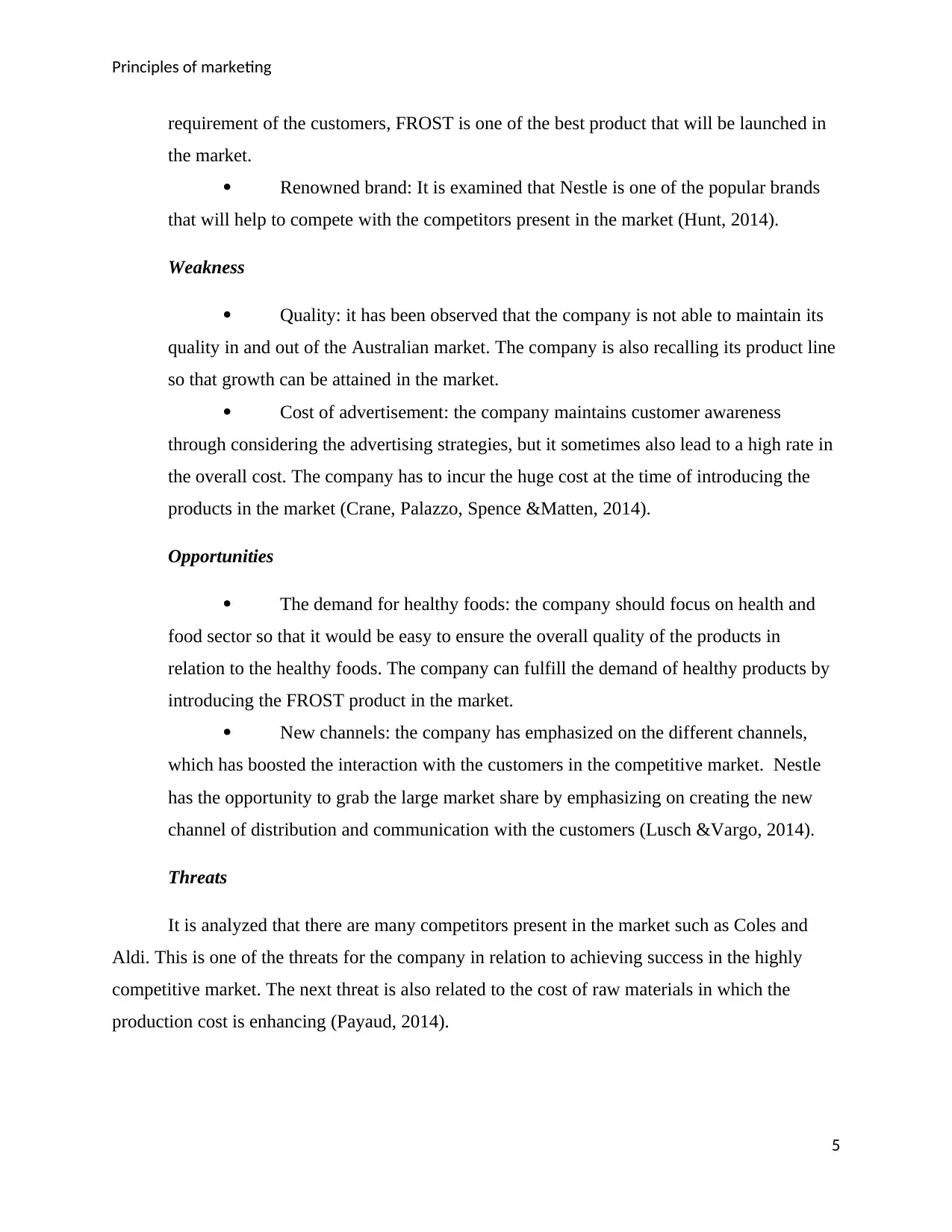
Principles of marketing
requirement of the customers, FROST is one of the best product that will be launched in
the market.
Renowned brand: It is examined that Nestle is one of the popular brands
that will help to compete with the competitors present in the market (Hunt, 2014).
Weakness
Quality: it has been observed that the company is not able to maintain its
quality in and out of the Australian market. The company is also recalling its product line
so that growth can be attained in the market.
Cost of advertisement: the company maintains customer awareness
through considering the advertising strategies, but it sometimes also lead to a high rate in
the overall cost. The company has to incur the huge cost at the time of introducing the
products in the market (Crane, Palazzo, Spence &Matten, 2014).
Opportunities
The demand for healthy foods: the company should focus on health and
food sector so that it would be easy to ensure the overall quality of the products in
relation to the healthy foods. The company can fulfill the demand of healthy products by
introducing the FROST product in the market.
New channels: the company has emphasized on the different channels,
which has boosted the interaction with the customers in the competitive market. Nestle
has the opportunity to grab the large market share by emphasizing on creating the new
channel of distribution and communication with the customers (Lusch &Vargo, 2014).
Threats
It is analyzed that there are many competitors present in the market such as Coles and
Aldi. This is one of the threats for the company in relation to achieving success in the highly
competitive market. The next threat is also related to the cost of raw materials in which the
production cost is enhancing (Payaud, 2014).
5
requirement of the customers, FROST is one of the best product that will be launched in
the market.
Renowned brand: It is examined that Nestle is one of the popular brands
that will help to compete with the competitors present in the market (Hunt, 2014).
Weakness
Quality: it has been observed that the company is not able to maintain its
quality in and out of the Australian market. The company is also recalling its product line
so that growth can be attained in the market.
Cost of advertisement: the company maintains customer awareness
through considering the advertising strategies, but it sometimes also lead to a high rate in
the overall cost. The company has to incur the huge cost at the time of introducing the
products in the market (Crane, Palazzo, Spence &Matten, 2014).
Opportunities
The demand for healthy foods: the company should focus on health and
food sector so that it would be easy to ensure the overall quality of the products in
relation to the healthy foods. The company can fulfill the demand of healthy products by
introducing the FROST product in the market.
New channels: the company has emphasized on the different channels,
which has boosted the interaction with the customers in the competitive market. Nestle
has the opportunity to grab the large market share by emphasizing on creating the new
channel of distribution and communication with the customers (Lusch &Vargo, 2014).
Threats
It is analyzed that there are many competitors present in the market such as Coles and
Aldi. This is one of the threats for the company in relation to achieving success in the highly
competitive market. The next threat is also related to the cost of raw materials in which the
production cost is enhancing (Payaud, 2014).
5
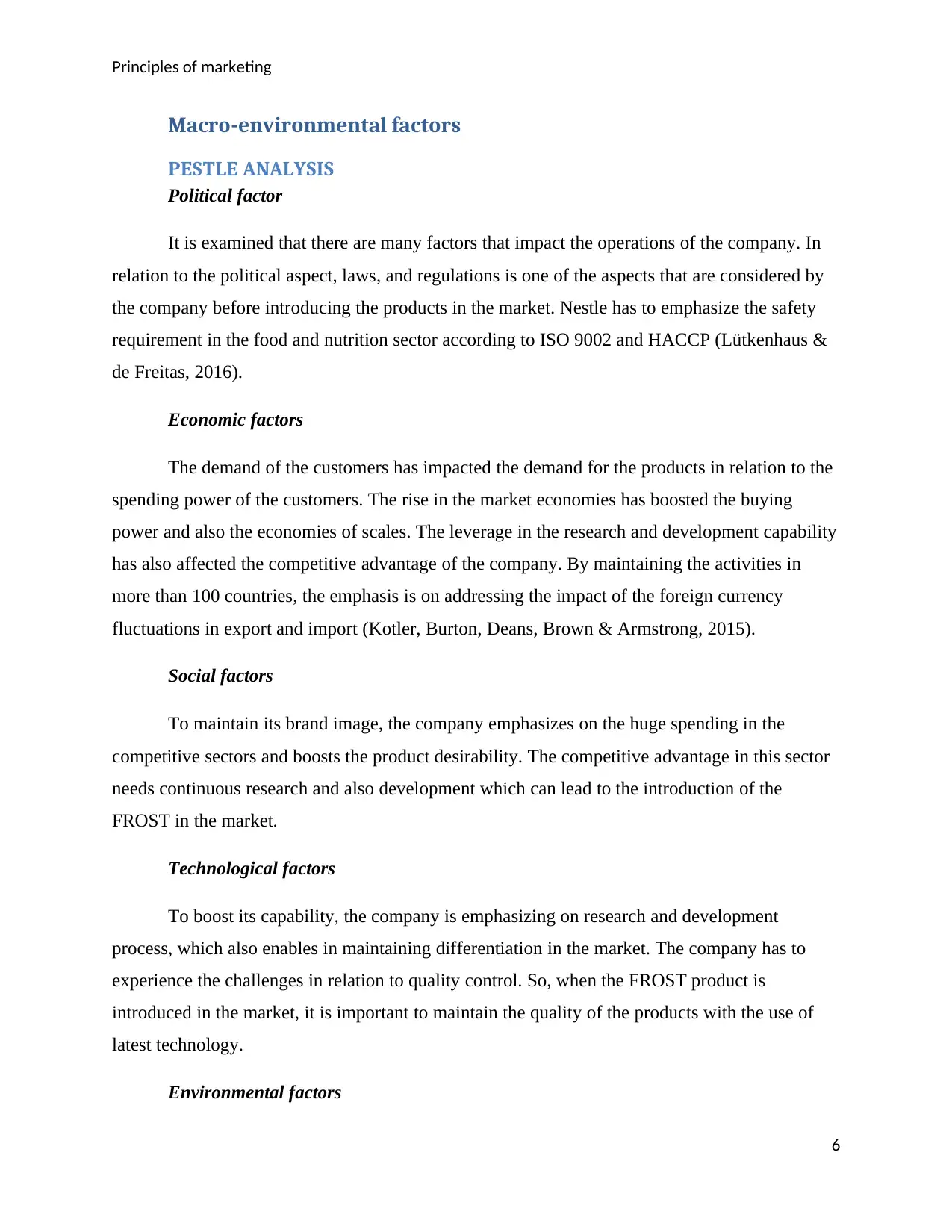
Principles of marketing
Macro-environmental factors
PESTLE ANALYSIS
Political factor
It is examined that there are many factors that impact the operations of the company. In
relation to the political aspect, laws, and regulations is one of the aspects that are considered by
the company before introducing the products in the market. Nestle has to emphasize the safety
requirement in the food and nutrition sector according to ISO 9002 and HACCP (Lütkenhaus &
de Freitas, 2016).
Economic factors
The demand of the customers has impacted the demand for the products in relation to the
spending power of the customers. The rise in the market economies has boosted the buying
power and also the economies of scales. The leverage in the research and development capability
has also affected the competitive advantage of the company. By maintaining the activities in
more than 100 countries, the emphasis is on addressing the impact of the foreign currency
fluctuations in export and import (Kotler, Burton, Deans, Brown & Armstrong, 2015).
Social factors
To maintain its brand image, the company emphasizes on the huge spending in the
competitive sectors and boosts the product desirability. The competitive advantage in this sector
needs continuous research and also development which can lead to the introduction of the
FROST in the market.
Technological factors
To boost its capability, the company is emphasizing on research and development
process, which also enables in maintaining differentiation in the market. The company has to
experience the challenges in relation to quality control. So, when the FROST product is
introduced in the market, it is important to maintain the quality of the products with the use of
latest technology.
Environmental factors
6
Macro-environmental factors
PESTLE ANALYSIS
Political factor
It is examined that there are many factors that impact the operations of the company. In
relation to the political aspect, laws, and regulations is one of the aspects that are considered by
the company before introducing the products in the market. Nestle has to emphasize the safety
requirement in the food and nutrition sector according to ISO 9002 and HACCP (Lütkenhaus &
de Freitas, 2016).
Economic factors
The demand of the customers has impacted the demand for the products in relation to the
spending power of the customers. The rise in the market economies has boosted the buying
power and also the economies of scales. The leverage in the research and development capability
has also affected the competitive advantage of the company. By maintaining the activities in
more than 100 countries, the emphasis is on addressing the impact of the foreign currency
fluctuations in export and import (Kotler, Burton, Deans, Brown & Armstrong, 2015).
Social factors
To maintain its brand image, the company emphasizes on the huge spending in the
competitive sectors and boosts the product desirability. The competitive advantage in this sector
needs continuous research and also development which can lead to the introduction of the
FROST in the market.
Technological factors
To boost its capability, the company is emphasizing on research and development
process, which also enables in maintaining differentiation in the market. The company has to
experience the challenges in relation to quality control. So, when the FROST product is
introduced in the market, it is important to maintain the quality of the products with the use of
latest technology.
Environmental factors
6

Principles of marketing
Nestle is also engaged in the different programs that focus on maintaining the eco-
friendly environment. But sometimes the company has also been criticized because of the weak
approach considered to manage the operations. By introducing the FROST product, it is
necessary to consider the eco-friendly approach to promote promoting the services provided to
the customers (Moura, Branco &Camoesas, 2015).
Legal factor
It is analyzed that Nestle has endowed the legal capabilities which are important to be
considered. Also, mergers and acquisition have enabled the company to diversify at the time of
new entry of the products. So, it is important for the company to focus on these factors at the
time of entering into the Australian market and also at the time of introducing FROST in the
highly competitive market (Krafft, Goetz, Mantrala, Sotgiu &Tillmanns, 2015).
Market segmentation
Geographical Segmentation
The customers of the urban areas will be targeted. It is examined that Nestle has effective
distribution channel that could assist the company in purchasing products. The product should be
offered in hypermarkets like Aldi and also in the supermarkets like Seven Eleven. The local
outlets and cafes will be the target for the product. Also, it is important to ensure that the drink is
supplied in the sports events so that the demand for the products can be boosted.
Demographic segmentation
The target audience of the product should be from 15 to 54 so that it could be easy to
promote the product effectively. To attract the youngsters, towards the products it is important to
distribute the free samples in the events. It will help to boost the demand for the products and
also will maintain a large customer base (Saluja &Mahajan, 2017).
Behavioral segmentation
This product will be more preferred by the youngsters or by the people who take
precaution to maintain their health. It is seen that in the present scenario, the demand for the
healthy product is enhancing so that customers will prefer FROST which will be introduced by
the Nestle Company.
7
Nestle is also engaged in the different programs that focus on maintaining the eco-
friendly environment. But sometimes the company has also been criticized because of the weak
approach considered to manage the operations. By introducing the FROST product, it is
necessary to consider the eco-friendly approach to promote promoting the services provided to
the customers (Moura, Branco &Camoesas, 2015).
Legal factor
It is analyzed that Nestle has endowed the legal capabilities which are important to be
considered. Also, mergers and acquisition have enabled the company to diversify at the time of
new entry of the products. So, it is important for the company to focus on these factors at the
time of entering into the Australian market and also at the time of introducing FROST in the
highly competitive market (Krafft, Goetz, Mantrala, Sotgiu &Tillmanns, 2015).
Market segmentation
Geographical Segmentation
The customers of the urban areas will be targeted. It is examined that Nestle has effective
distribution channel that could assist the company in purchasing products. The product should be
offered in hypermarkets like Aldi and also in the supermarkets like Seven Eleven. The local
outlets and cafes will be the target for the product. Also, it is important to ensure that the drink is
supplied in the sports events so that the demand for the products can be boosted.
Demographic segmentation
The target audience of the product should be from 15 to 54 so that it could be easy to
promote the product effectively. To attract the youngsters, towards the products it is important to
distribute the free samples in the events. It will help to boost the demand for the products and
also will maintain a large customer base (Saluja &Mahajan, 2017).
Behavioral segmentation
This product will be more preferred by the youngsters or by the people who take
precaution to maintain their health. It is seen that in the present scenario, the demand for the
healthy product is enhancing so that customers will prefer FROST which will be introduced by
the Nestle Company.
7
Paraphrase This Document
Need a fresh take? Get an instant paraphrase of this document with our AI Paraphraser

Principles of marketing
Psychological segmentation
Nestle focuses on maintaining the lifestyle of the people by offering them quality
products in the market. The company market itself as a healthy product offered in the market. In
relation to this product, the company will emphasize on keeping the people healthy and energetic
by introducing the fruit drink in the market (Dunning, 2014).
Target marketing and positioning strategies
The targeting strategy that should be considered by the company is to offer the products
in the gym and also in the sports events so that individuals can gain energy after consuming it.
The energy drink will focus on the youth and adults of the Australian market, as it has been seen
that the customer base is large of energy drinks in Australia. To position the product the
company should consider distribution and social media marketing as it will help in boosting the
demand for the product (Patrizia &Gianluca, 2013).
Conclusion
Therefore, it is concluded that the company should introduce the FROST product in the
Australian market, as there are a majority of the people who are health conscious. It has also
been seen that the population of the Australian is more than 2, 30,000 and approximately there
are 89% of individuals who are living in the urban areas. So, this market is selected to position
the product. It is necessary for the company to consider these marketing environmental factors
before introducing the product in the market, as it can help in boosting the demand for the
product in the highly competitive market. The company should target adults and youngsters so
that it could be easy to maintain its competitive advantage in the market. So, it can be concluded
that the company should focus on introducing the product in the Australian market as it could be
boost the product demand in the market and also it will help in maintaining the large market
share.
8
Psychological segmentation
Nestle focuses on maintaining the lifestyle of the people by offering them quality
products in the market. The company market itself as a healthy product offered in the market. In
relation to this product, the company will emphasize on keeping the people healthy and energetic
by introducing the fruit drink in the market (Dunning, 2014).
Target marketing and positioning strategies
The targeting strategy that should be considered by the company is to offer the products
in the gym and also in the sports events so that individuals can gain energy after consuming it.
The energy drink will focus on the youth and adults of the Australian market, as it has been seen
that the customer base is large of energy drinks in Australia. To position the product the
company should consider distribution and social media marketing as it will help in boosting the
demand for the product (Patrizia &Gianluca, 2013).
Conclusion
Therefore, it is concluded that the company should introduce the FROST product in the
Australian market, as there are a majority of the people who are health conscious. It has also
been seen that the population of the Australian is more than 2, 30,000 and approximately there
are 89% of individuals who are living in the urban areas. So, this market is selected to position
the product. It is necessary for the company to consider these marketing environmental factors
before introducing the product in the market, as it can help in boosting the demand for the
product in the highly competitive market. The company should target adults and youngsters so
that it could be easy to maintain its competitive advantage in the market. So, it can be concluded
that the company should focus on introducing the product in the Australian market as it could be
boost the product demand in the market and also it will help in maintaining the large market
share.
8
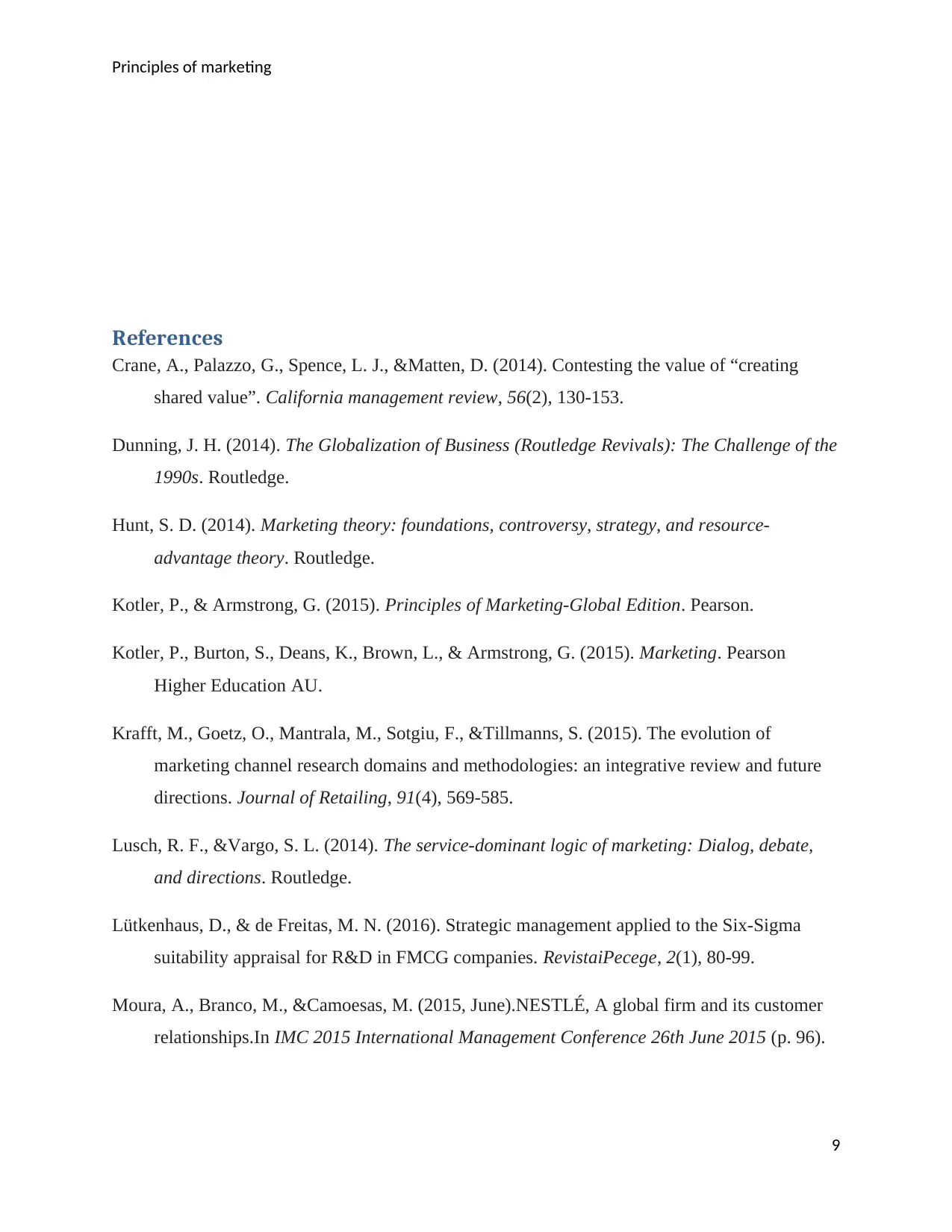
Principles of marketing
References
Crane, A., Palazzo, G., Spence, L. J., &Matten, D. (2014). Contesting the value of “creating
shared value”. California management review, 56(2), 130-153.
Dunning, J. H. (2014). The Globalization of Business (Routledge Revivals): The Challenge of the
1990s. Routledge.
Hunt, S. D. (2014). Marketing theory: foundations, controversy, strategy, and resource-
advantage theory. Routledge.
Kotler, P., & Armstrong, G. (2015). Principles of Marketing-Global Edition. Pearson.
Kotler, P., Burton, S., Deans, K., Brown, L., & Armstrong, G. (2015). Marketing. Pearson
Higher Education AU.
Krafft, M., Goetz, O., Mantrala, M., Sotgiu, F., &Tillmanns, S. (2015). The evolution of
marketing channel research domains and methodologies: an integrative review and future
directions. Journal of Retailing, 91(4), 569-585.
Lusch, R. F., &Vargo, S. L. (2014). The service-dominant logic of marketing: Dialog, debate,
and directions. Routledge.
Lütkenhaus, D., & de Freitas, M. N. (2016). Strategic management applied to the Six-Sigma
suitability appraisal for R&D in FMCG companies. RevistaiPecege, 2(1), 80-99.
Moura, A., Branco, M., &Camoesas, M. (2015, June).NESTLÉ, A global firm and its customer
relationships.In IMC 2015 International Management Conference 26th June 2015 (p. 96).
9
References
Crane, A., Palazzo, G., Spence, L. J., &Matten, D. (2014). Contesting the value of “creating
shared value”. California management review, 56(2), 130-153.
Dunning, J. H. (2014). The Globalization of Business (Routledge Revivals): The Challenge of the
1990s. Routledge.
Hunt, S. D. (2014). Marketing theory: foundations, controversy, strategy, and resource-
advantage theory. Routledge.
Kotler, P., & Armstrong, G. (2015). Principles of Marketing-Global Edition. Pearson.
Kotler, P., Burton, S., Deans, K., Brown, L., & Armstrong, G. (2015). Marketing. Pearson
Higher Education AU.
Krafft, M., Goetz, O., Mantrala, M., Sotgiu, F., &Tillmanns, S. (2015). The evolution of
marketing channel research domains and methodologies: an integrative review and future
directions. Journal of Retailing, 91(4), 569-585.
Lusch, R. F., &Vargo, S. L. (2014). The service-dominant logic of marketing: Dialog, debate,
and directions. Routledge.
Lütkenhaus, D., & de Freitas, M. N. (2016). Strategic management applied to the Six-Sigma
suitability appraisal for R&D in FMCG companies. RevistaiPecege, 2(1), 80-99.
Moura, A., Branco, M., &Camoesas, M. (2015, June).NESTLÉ, A global firm and its customer
relationships.In IMC 2015 International Management Conference 26th June 2015 (p. 96).
9
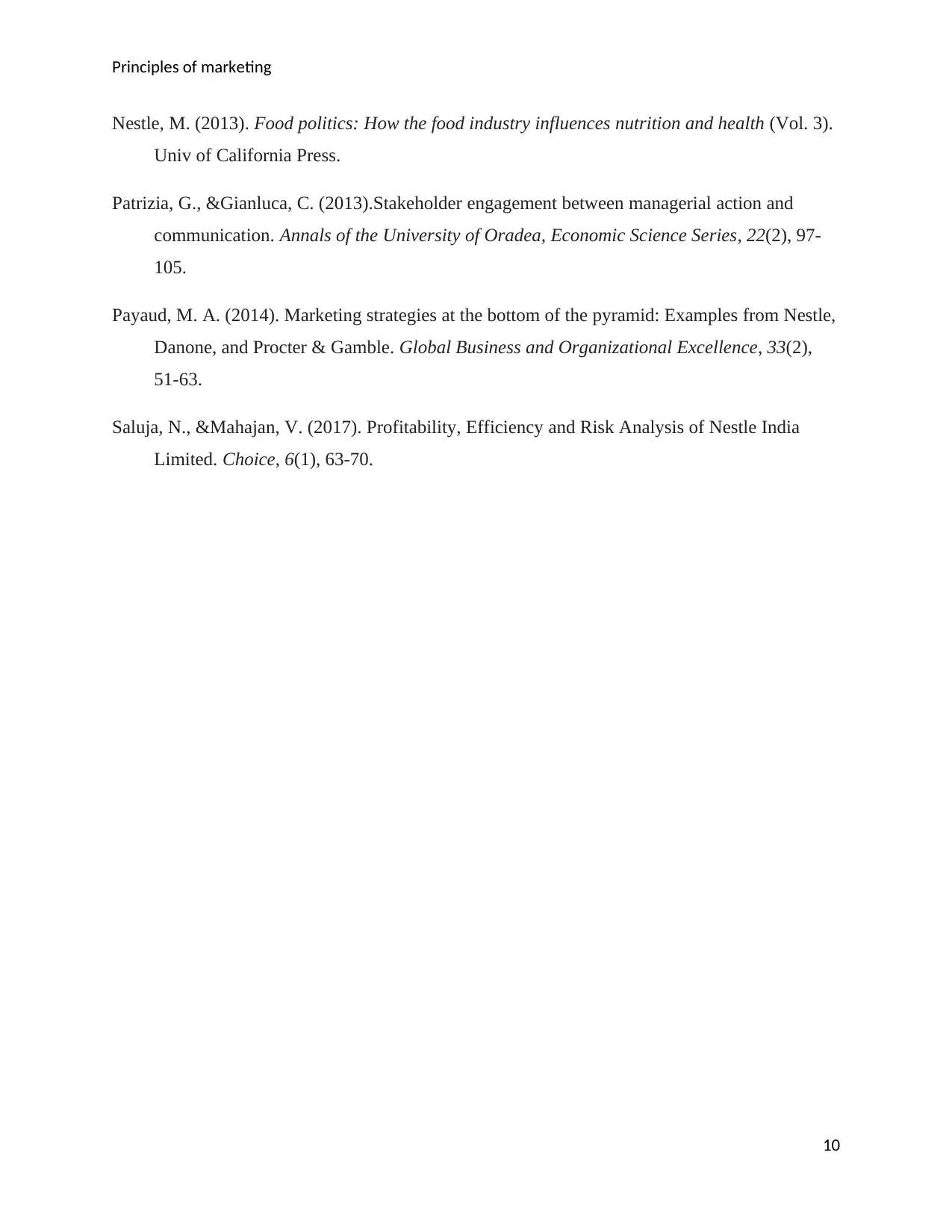
Principles of marketing
Nestle, M. (2013). Food politics: How the food industry influences nutrition and health (Vol. 3).
Univ of California Press.
Patrizia, G., &Gianluca, C. (2013).Stakeholder engagement between managerial action and
communication. Annals of the University of Oradea, Economic Science Series, 22(2), 97-
105.
Payaud, M. A. (2014). Marketing strategies at the bottom of the pyramid: Examples from Nestle,
Danone, and Procter & Gamble. Global Business and Organizational Excellence, 33(2),
51-63.
Saluja, N., &Mahajan, V. (2017). Profitability, Efficiency and Risk Analysis of Nestle India
Limited. Choice, 6(1), 63-70.
10
Nestle, M. (2013). Food politics: How the food industry influences nutrition and health (Vol. 3).
Univ of California Press.
Patrizia, G., &Gianluca, C. (2013).Stakeholder engagement between managerial action and
communication. Annals of the University of Oradea, Economic Science Series, 22(2), 97-
105.
Payaud, M. A. (2014). Marketing strategies at the bottom of the pyramid: Examples from Nestle,
Danone, and Procter & Gamble. Global Business and Organizational Excellence, 33(2),
51-63.
Saluja, N., &Mahajan, V. (2017). Profitability, Efficiency and Risk Analysis of Nestle India
Limited. Choice, 6(1), 63-70.
10
1 out of 10
Related Documents
Your All-in-One AI-Powered Toolkit for Academic Success.
+13062052269
info@desklib.com
Available 24*7 on WhatsApp / Email
![[object Object]](/_next/static/media/star-bottom.7253800d.svg)
Unlock your academic potential
© 2024 | Zucol Services PVT LTD | All rights reserved.





